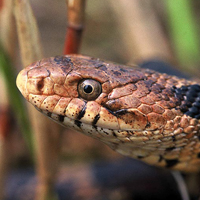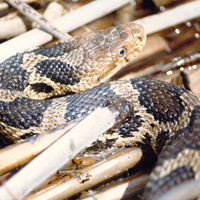Eastern Foxsnake
Scientific name: Pantherophis vulpinus



Cover photos credit: Scott Gillingwater (all photos)
Status
Threatened (Carolinian and Great Lakes / St. Lawrence populations)
Threatened
means the species lives in the wild in Ontario, is not endangered, but is likely to become endangered if steps are not taken to address factors threatening it.
Date added to the Species at Risk in Ontario List
September 10, 2009
On January 29, 2024, the scientific name of this species was updated on the Ontario Regualtion 230/08: Species at Risk in Ontario List from Pantherophis gloydi to Pantherophis vulpinus.
The common name of the Georgian Bay population changed to the Great Lakes / St. Lawrence population to be consistent with recent nomenclatural and taxonomic changes.
The changes made to the species’ common and scientific name do not change the protections afforded to the species under the Endangered Species Act, 2007 or the applicability of any policies, permits and agreements, guidance documents — including recovery guidance – or best management practices that have been published or issued by the Government of Ontario in respect of the species.
Read the most recent assessment report for the Carolinian population [PDF]
Read the most recent assessment report for the Great Lakes / St. Lawrence population [PDF]
What it looks like
Eastern Foxsnake is one of Ontario’s largest snakes, reaching over 1.7 metres in length. This beautiful snake usually has a shiny, rusty orange head and a golden to light brown body with dark blotches. The belly is light yellow and black.
Where it lives
Eastern Foxsnakes in the Carolinian population are usually found in:
- old fields
- marshes
- along hedgerows
- drainage canals
- shorelines
Females lay their eggs in rotting logs, manure or compost piles, which naturally incubate the eggs until they hatch.
Individuals from the Great Lakes / St. Lawrence population are usually found within 150 metres of the shore in rocky habitats spotted with trees and shrubs.
During the winter, Eastern Foxsnakes hibernate in groups in deep cracks in the bedrock and in some man-made structures.
The range of Eastern Foxsnake spans from the Great Lakes region to the Mississippi River. In Canada the species is only found in Ontario. In the United States the species is found in:
- Illinois
- Indiana
- Michigan
- Missouri
- Ohio
- Wisconsin
Where it’s been found in Ontario
Ontario contains 70% of their range in two distinct populations: the Carolinian population in southwestern Ontario and the eastern Great Lakes / St. Lawrence population.
What threatens it
The greatest threats to Eastern Foxsnake are habitat loss and fragmentation (when habitat is broken into smaller segments) due to shoreline development and draining wetlands. Sadly, some snakes are also hit by cars and deliberately killed by humans. Illegal collecting can also harm populations of this snake.
Action we are taking
This species and its habitat are protected under Ontario’s Endangered Species Act, 2007 (ESA).
The ESA also requires us to prepare recovery guidance for threatened species such as the Carolinian and Great Lakes / St. Lawrence populations of Eastern Foxsnake.
All species listed on the Species at Risk in Ontario List may be eligible for consideration for government funding through the Species at Risk Stewardship Program.
Recovery strategy
A recovery strategy advises the ministry on ways to ensure healthy numbers of the species return to Ontario.
Read the executive summary (September 10, 2010)
Read the recovery strategy (September 10, 2010)
Government response statement
A government response statement outlines the actions the government intends to take or support to help recover the species.
Read the government response statement (June 15, 2011)
Five-year review of progress
A five-year review reports on progress made toward protecting and recovering a species, within five years of publishing a species’ government response statement.
Read the report on progress towards the protection and recovery of 27 species at risk, including Eastern Foxsnake (2016).
Habitat protection
A habitat regulation defines a species' habitat and many describe features (for example, a creek, cliff, or beach), geographic boundaries or other unique characteristics.
Read the habitat summary for the Carolinian population (July 1, 2012)
Read the habitat summary for the Great Lakes / St. Lawrence population (formerly known as the Georgian Bay population) (July 1, 2012)
What you can do
Report a sighting
Submit your observations of species at risk to the Natural Heritage Information Centre (NHIC), which is Ontario’s conservation data centre. Join the “(NHIC Rare Species of Ontario” project in iNaturalist to make submitting your observations quick and easy.
Volunteer
Volunteer with your local nature club or provincial park to participate in surveys or stewardship work focused on species at risk.
Be a good steward
- Private landowners have a very important role to play in species recovery. If you find Eastern Foxsnake on your land, you may be eligible for stewardship programs that support the protection and recovery of species at risk and their habitats. Learn more about the Species at Risk Stewardship Program.
- Visit the Toronto Zoo Adopt-a-Pond website to learn more about Ontario’s rare snakes, their habitat and related conservation initiatives.
- You can help improve Eastern Foxsnake habitat by keeping your property as natural as possible. Leave brush piles and logs to decay where they lie.
- Never buy snakes that have been caught in the wild, and never buy a native species of any kind that’s being sold as a pet.
- Every year, snakes all over the province must cross busy roads. Watch for snakes on the road, especially between May and October.
- Appreciate snakes and don’t harm them. Keep the danger of snakes in perspective: all of Ontario’s snakes are non-venomous, except for the very rare and shy Massasauga.
Report illegal activity
Report any illegal activity related to plants and wildlife to
Quick facts
- If frightened, the harmless Eastern Foxsnake will mimic a rattlesnake by vibrating the tip of its tail in leaf litter to produce a buzzing noise. Don’t be fooled. The Massasauga rattlesnake has a real ‘rattle’ at the end of its tail, a darker background body colour (brown-grey), and a short thick body compared to the long and slender Eastern Foxsnake.
- The Eastern Foxsnake is a constrictor and suffocates prey such as larger rodents with the coils of its body. They also eat baby birds, eggs and frogs.
- Eastern Foxsnakes are excellent swimmers. You can distinguish the Eastern Foxsnake from a watersnake at a distance because the Foxsnake swims on the surface of the water, floating like a pool noodle, while a watersnake swims with only its head above the surface.